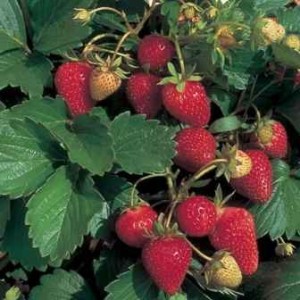Strawberries for Groundcover and for Fruit
 Question from Stanley:
Question from Stanley:
I live in Nevada City, California. This is my latest landscape project. (I am a computer programmer, but try to knock out a couple of home projects a year to make myself feel useful and adequate.) I had intended to plant creeping thyme or something aromatic like that. (The water is stubbed out to spray inward from both sides).
But I suddenly realized how much my teenage daughter likes strawberries. Obviously I would have to constantly trim them back so they don’t take over the stepping stones. But on a hot morning, think of the aroma…..
Would they be brown all winter when it freezes? I suppose that would be okay. It’s a blighted landscape here in the winter anyway. Nothing much grows. What variety would you suggest? Long-bearing, sweet…My daughter’s bedroom is right above there, so she could survey the crop each morning when she wakes up.
Answer from Pat:
Your query brings up several subjects of special interest to organic gardeners. One of the important considerations for all organic gardeners is “right plant for right place.” The placement of the planting area surrounding stepping stones and your consideration of creeping thyme for that area suggests that you want a ground cover, but your question about varieties of edible strawberries would indicate that you wish to plant a fruiting variety. In general, ground cover varieties of strawberry and edible strawberry varieties are not interchangeable and do not serve the same purpose. Edible varieties don’t make good ground covers and most ground cover varieties don’t bear good fruit.
Most commercial and home-garden edible strawberries are complex hybrids lumped under the botanical name Fragaria x annanasa. Most are crosses of Fragaria chiloensis and F. virginiana and other wild types such as F. vesca, and they have been crossed and recrossed to bring out many different characteristics, including flavor, size, whether a variety is ever-bearing, early, mid-season, or late fruiting, and adaptability to various climates. The varieties of strawberries are all developed for specific climate zones and therefore are one of the most regional of crops both commercially and also in home gardens, but in most areas one has several varieties from which to choose. It is always wise to consult with one’s local UC Extension scientists to find out the best varieties for your area. After doing that you can then study the characteristics of the varieties that you especially like and want. I favor ‘Chandler’ for example for its flavor and size and it bears over a long season. It does grow well in your area as an annual plant. You would need to plant fresh plants each spring, or might be able to save your runners in the house or bareroot and replant in spring. I also like the variety ‘Camarosa’ but it gets mildew and may not be as well adapted to mountain climates.
Ground cover types of strawberries, any of which will grow as permanent plants in your climate, include Fragaria chiloensis which bears no edible fruit. Mow it or cut it back annually in spring to keep it compact and force new growth. Follow up with organic fertilizer. You might also choose F. ‘Lipstick’, and F. ‘Pink Panda’ (both of these latter varieties are highly ornamental and have lovely pink flowers) or alpine strawberry (F. vesca). However, I find this grows best in containers and it is clumping—i.e.: It does not have runners. I love the fruit of this one however and I have found it easy to grow in containers. One type has yellow fruit and tastes great but I like the red ones best because of the color. A strawberry pot works well but I grew them in tall terra cotta pots.
The space in your photograph looks to me as if it is good for a ground cover and not good for growing edible strawberries. In cold-winter climates, such as Sunset Zone 7 where you live, it is best to plant and grow strawberries for eating in a vegetable garden and to treat them as an annual plant, replanting each year in spring. Many home gardeners plant strawberries as annuals and this is the way all commercial growers handle this crop, though the dates for planting differ regionally and also the varieties differ. In the space your photo shows it would be difficult for you to pull out the plants annually and then amend and fertilize the soil after which you would replant every spring. Additionally, the placement of this area is such that dogs and animals might walk across it thus ruining your crop. Slugs, snails, sowbugs and other ground pests as well as birds would be likely to get the crop before you or your daughter would be able to do so.
One possibility is that you decide on a ground cover for this area, whether fragaria or not, and then adopt the making of a raised bed nearby as one of your future home projects. It could even be built as a special design enhancement of this path, like an ornamental walled area next to it, so that as you walk or stand on the path you can easily tend and pick the berries and also cover them with netting if necessary against birds. An attractive copper edging, good looking in all seasons, could keep out slugs and snails.
For this year I suggest you plant the area solidly with Fragaria ‘Pink Panda’, then purchase tall narrow pots, placing them artistically here and there on the left of the path and installing a drip system to water them. Plant them with F. vesca and fertilize them organically. This would be a fun way to begin this season and satisfy all requirements. Put in the strawberry raised bed at some future time.

